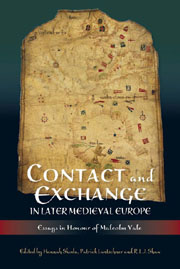Book contents
- Frontmatter
- Contents
- List of Illustrations
- List of Contributors
- Acknowledgements
- The Work of Malcolm Vale
- Principal Bibliography of Malcolm Vale
- Introduction
- Part I Boundaries and Units
- Part II Practices of Exchange
- Introduction
- In and Out of Africa: Iberian Courts and the Afro-Portuguese Olifant of the Late 1400s
- The Knowledge and Use of the ‘Teachings of Saint Louis’ in Fourteenth-Century England
- Philip of Chieti in Flanders, 1303–1305
- The Last Week of the Life of Edward the Black Prince
- Tournament Culture in the Low Countries and England
- Conclusions
- Index
- Tabula Gratulatoria
In and Out of Africa: Iberian Courts and the Afro-Portuguese Olifant of the Late 1400s
from Part II - Practices of Exchange
Published online by Cambridge University Press: 05 February 2013
- Frontmatter
- Contents
- List of Illustrations
- List of Contributors
- Acknowledgements
- The Work of Malcolm Vale
- Principal Bibliography of Malcolm Vale
- Introduction
- Part I Boundaries and Units
- Part II Practices of Exchange
- Introduction
- In and Out of Africa: Iberian Courts and the Afro-Portuguese Olifant of the Late 1400s
- The Knowledge and Use of the ‘Teachings of Saint Louis’ in Fourteenth-Century England
- Philip of Chieti in Flanders, 1303–1305
- The Last Week of the Life of Edward the Black Prince
- Tournament Culture in the Low Countries and England
- Conclusions
- Index
- Tabula Gratulatoria
Summary
Among the masterpieces on display at the National Museum of African Art in Washington, DC, is a majestic elephant tusk dating from the late fifteenth century. Standing just over twenty-five inches high, the tusk is elaborately decorated and opened at its narrow end to make it into an ‘olifant’, a medieval name for ivory horns used for hunting calls or as an emblem of office. The complex and masterfully executed reliefs that run the olifant's entire length depict scenes of stag hunting. Heraldic emblems carved at its lower section attest to the high social rank both of the person who commissioned its manufacture and of the recipient who came to own it. In all likelihood, this extraordinary artefact served as a gift to be offered by one nobleman or prince to another.
While the hand that sculpted the olifant can be identified with certainty as African, the iconography of the reliefs is unquestionably European. The combination bears witness to the crossing of both geographical and cultural borders that occurred during the fifteenth century as a consequence of Portuguese sea voyages. This hunting horn does not stand alone at the intersection of distinct cultures. Numerous other examples of African art also illustrate the cross-cultural fertility resulting from the engagement of African societies with Europe through trade and other forms of exchange in the late medieval period. As commodities of intercultural trade, these objects are interesting for what they can reveal about the African experiences of contact with Europeans in the late fifteenth century.
- Type
- Chapter
- Information
- Contact and Exchange in Later Medieval EuropeEssays in Honour of Malcolm Vale, pp. 167 - 188Publisher: Boydell & BrewerPrint publication year: 2012



